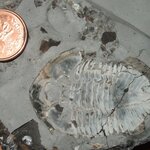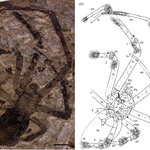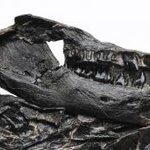Paleontology

I'll share with you my most recent finds, which I found at Craigleith last weekend in a brief interlude from the fieldwork that I'm doing down the road from there:
Pseudogygites latimarginensis. I believe the species was called canadensis, but this has since been subsumed. They're from the late orovician Craigleith shale, outcropping at Delphi point, Craigleith, in Ontario, Canada.
A lot of people will know what these are: they're trilobites - the masters of the Paleozoic seas. For 300 million years, trilobites reined supreme, right from the Cambrian until they met their final demise in the…

Hello to the K. B. Polk 4th graders!
I enjoyed your visit to Cedar Ridge Natural Preserve. As I told some of you, I'm a scientist and I was going out to South Texas that weekend to find some dinosaur prints. I told your teachers I'd write a letter about my adventures, because scientists love having adventures.
I saw the footprint -- I think it's a footprint -- about a year ago on a trip to look at rock art. As I was hurrying across the flat limestone beside the river I stepped right over a strange-looking depression in the rock. "Looks like a dinosaur footprint!" I…

Elasmosaurs loved their gastroliths – round, polished stomach stones – have been found amid their bones. These stones would have been swallowed to help grind down their catch and lower their natural buoyancy. Surprisingly elasmosaurs displayed a remarkable discernment in their selection of pebbles. The Puntledge elasmosaur from Courtenay, British Columbia, for example, had a yen extrusive volcanic rock. When the fossilized skeleton was excavated, every last one of the stones in its abdominal cavity were basalt.

Elasmosaurs loved their gastroliths – round, polished stomach stones – have been found amid their bones. These stones would have been swallowed to help grind down their catch and lower their natural buoyancy. Surprisingly elasmosaurs displayed a remarkable discernment in their selection of pebbles. The Puntledge elasmosaur from Courtenay, British Columbia, for example, had a yen extrusive volcanic rock. When the fossilized skeleton was excavated, every last one of the stones in its abdominal cavity were basalt.

What do you get if you mix a jellysifh (Peytoia), a sponge (Laggania), a crustacean tail, a crustacean abdomen (Tuzoia) and some Sidneyia tails?
The answer is Anomalocaris, a very unusual fossil from the famous Burgess shale.
Anomalocaris is a poster child for one of the most annoying aspects of paleontology: the fact that, rather rudely, body parts are not all made of the same stuff, and moreover, some animals have the cheek to rot and fall apart after they die.
The original "Anomalocaris" referred to this fossil below, which was assumed to be the body and tail of something like a shrimp…
Cute!! Well, not really, but it's still just about big enough to play on the swings with you.
Unlike his rather more terrifying parents, who might have rather impolitely eaten you for dinner, this little guy didn't have the strength in its jaws to munch on such large things, so instead would have subsided principally on small, bite sized reptiles. He (they don't actually know the sex, but hey, lets call him a he) was probably around 2 or 3 when he died, which is about 7 or 8 in human years.
Mummy and Daddy probably didn't travel with him and were probably off hunting on their own. I wonder…
This week's Friday Fossil is Helicoprion.
What can I say. This is one weird bastard. And it used to look even weirder,
The story is like this. At the turn of the last century, people started to find these strange dinner plate sized fossils that look superficially like ammonites,
But then, on closer inspection, they look uncannily like shark teeth...
It became part of the life's work of a russian paleontologist named Andrzej P. Karpinski to reconstruct this beast, though he might have had more success by staging a "pin the whorl on the Helicoprion" at his son's birthday party. First of all…
This week's Friday Fossil is Helicoprion.
What can I say. This is one weird bastard. And it used to look even weirder,
The story is like this. At the turn of the last century, people started to find these strange dinner plate sized fossils that look superficially like ammonites,
But then, on closer inspection, they look uncannily like shark teeth...
It became part of the life's work of a russian paleontologist named Andrzej P. Karpinski to reconstruct this beast. He tried it on the dorsal fin, like a windmill. He tried it on the tail, like a piglet. He even tried it on the tip of its nose…

Nephila, orb web weavers of golden silk traps up to five feet in diameter that snare bats in tropical regions, have a new relative that lived with the dinosaurs 165 million years ago and named it Nephila jurassica.
The previous oldest member of the family found was Cretaraneus vilaltae from Spain and the new find stretches nephila genus evolution back another 130 million years - and to Mongolia, when the north China block was part of the Pangaeasupercontinent.
Nephila jurassica is also only the second female fossil nephilid to be described.
In the Jurassic period, the…

Liaoconodon hui, a complete fossil mammal from the Mesozoic, has been found in China and includes a long-sought transitional middle ear. The specimen shows the bones associated with hearing in mammals (the malleus, incus, and ectotympanic) decoupled from the lower jaw, as had been predicted, but were held in place by an ossified cartilage that rested in a groove on the lower jaw.
The paper in Nature also suggests that the middle ear evolved at least twice in mammals, for monotremes and for the marsupial-placental group.
Mammals—the group of animals that includes egg-laying monotremes…